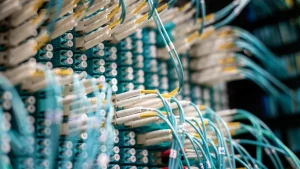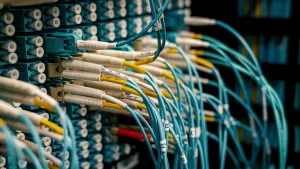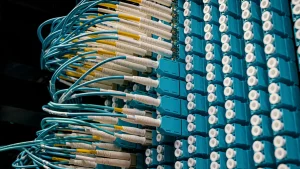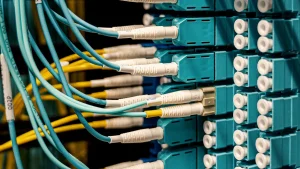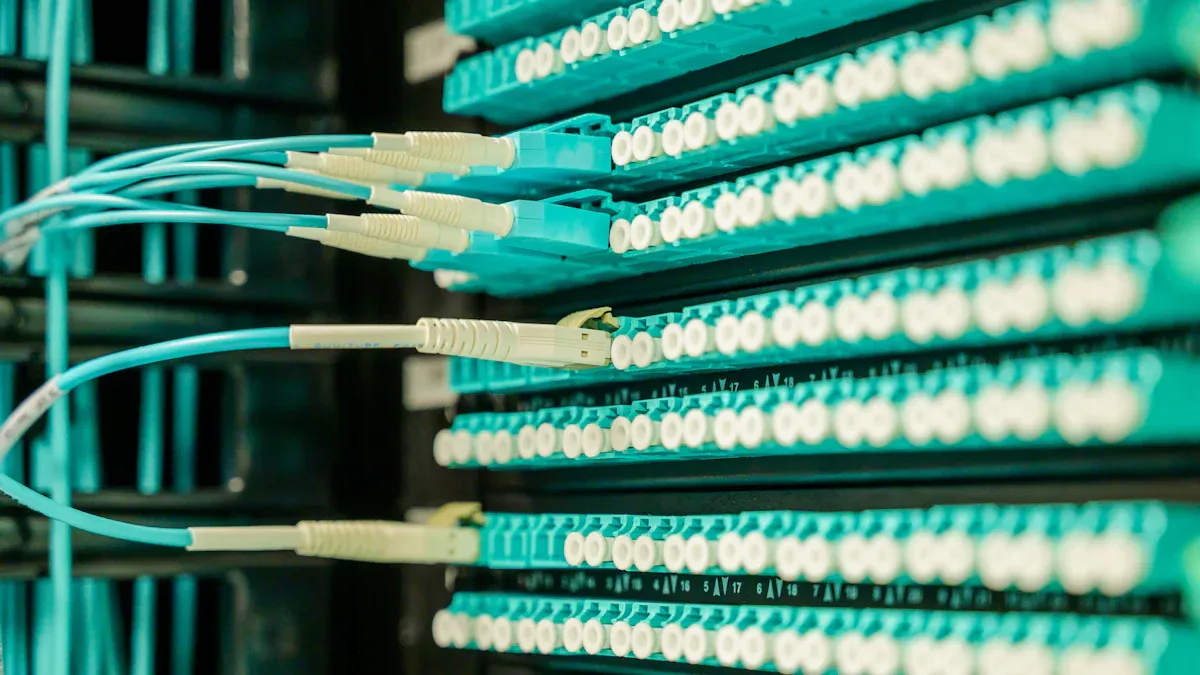
Data centers in 2025 rely on the MPO Patch Panel for high-density, scalable fiber connectivity. Leading models like Cisco, Corning, and FS.COM stand out for their port density, low insertion loss, and advanced design features. Cisco excels in demanding environments with premium performance. FS.COM offers cost-effective reliability, while Corning targets easy upgrades and labor savings. The market now shows a 25% share for MPO panels, with rapid growth driven by space efficiency and AI integration.

Key Takeaways
- MPO patch panels enable high-density fiber connections, saving space and supporting fast data speeds in data centers.
- These panels simplify cable management, reduce installation time, and allow easy upgrades to higher bandwidths like 400G.
- Top models differ in port density, scalability, ease of installation, and cable management features to fit various data center needs.
- Cisco offers robust, reliable panels ideal for mission-critical environments with flexible rack sizes and tool-less access.
- Eaton provides pre-configured, plug-and-play panels that speed up deployment and support spine-leaf network designs.
- CommScope and Leviton lead in ultra-high density solutions, perfect for large-scale data centers needing future-proof scalability.
- Proper installation and regular maintenance, including cleaning and labeling, are essential to maintain network performance.
- Choosing the right panel depends on your data center’s size, growth plans, fiber type, and compatibility with existing systems.
What Is an MPO Patch Panel and Why It Matters
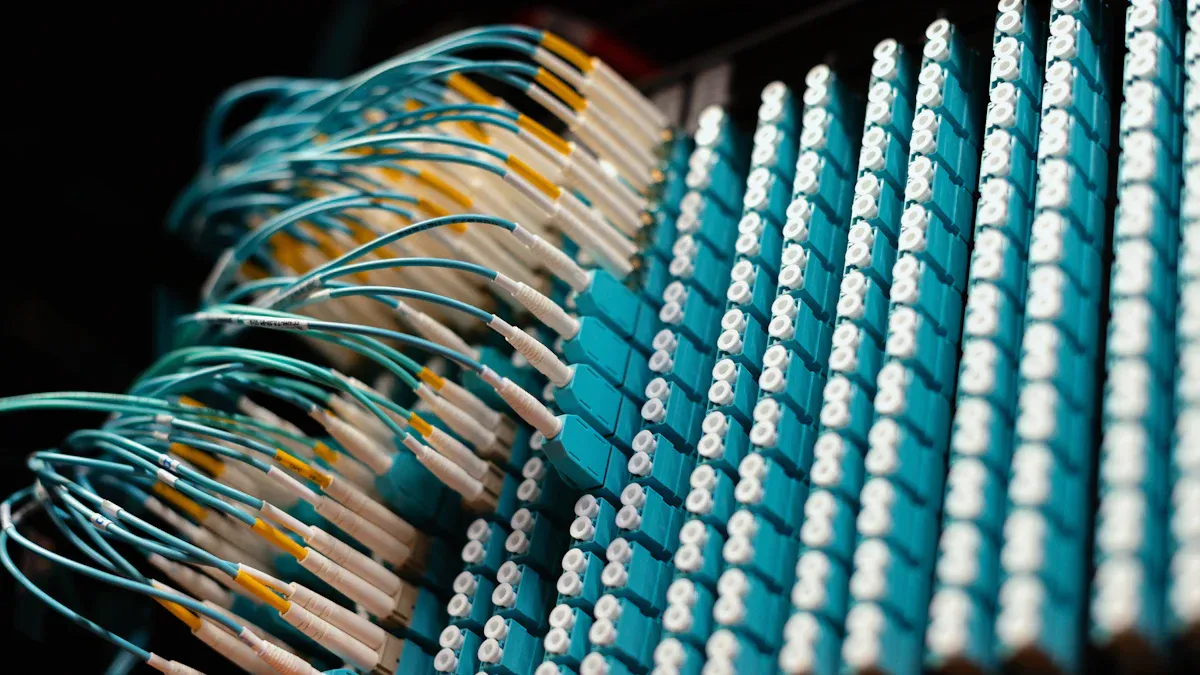
Definition and Core Functionality
An MPO Patch Panel serves as a high-density fiber optic connection solution in modern data centers. It uses multi-core fiber technology to connect multiple fiber cores within a single connector, which enables higher connection density in limited rack space. The panel typically accommodates 12, 24, or even 48 fibers in one MPO connector, making it ideal for environments that demand efficient fiber management.
- MPO connectors group several fibers together, streamlining cable organization.
- Flat ribbon cables allow parallel optical connections, which boost data transmission capacity.
- The panel acts as a centralized junction point, organizing fiber connections and maximizing space utilization.
- It supports high-speed switches and routers, enabling quick and reliable data routing.
- The design allows for compatibility with both single-mode and multi-mode fibers, offering flexibility for various network requirements.
MPO Patch Panels provide quick, reliable push-pull connections, which support rapid installation and easy maintenance. Each fiber core connects independently, so a failure in one does not affect the others. This structure enhances both flexibility and reliability in data center environments.
Importance for Data Center Performance
MPO Patch Panels play a crucial role in optimizing data center performance. Their high-density design supports rapid data transmission at speeds of 40G, 100G, and beyond. By consolidating multiple fibers into a single connector, these panels reduce cable clutter and free up valuable rack space. This streamlined approach minimizes points of failure and simplifies maintenance, which directly improves network reliability.
- High-density connections enable faster deployment and easier upgrades.
- The design supports seamless migration to higher bandwidths, such as 400G, without replacing the entire cabling infrastructure.
- Simplified cabling reduces maintenance requirements and speeds up troubleshooting.
- The space-saving layout improves airflow, which helps maintain optimal operating conditions.
MPO Patch Panels also future-proof data centers by allowing scalable upgrades. They support the growing demands of cloud computing, 5G, and IoT applications, ensuring that data centers remain agile and efficient.
Key Benefits Over Traditional Patch Panels
MPO Patch Panels offer several advantages compared to traditional patch panels:
- Significantly higher port density and space efficiency, reducing rack space requirements by up to 75%.
- Support for high bandwidth standards, including 40G, 100G, 400G, and 800G, which enables future scalability.
- Low insertion loss (≤0.35 dB) improves signal quality and overall network performance.
- Compatibility with multiple connector types allows seamless integration into existing infrastructures.
- Pre-terminated panels enable plug-and-play installation, reducing deployment time and minimizing network downtime.
- Simplified cable management lowers maintenance complexity and costs.
- Robust design ensures reliable operation across a wide temperature range.
Tip: MPO Patch Panels are optimized for backbone cabling in enterprise and data center environments, making them a future-proof choice for network growth.
Criteria for Comparing MPO Patch Panel Models
Port Density and Scalability
Port density remains a primary factor when evaluating MPO Patch Panel models for data centers. High-density panels maximize the number of fiber connections per rack unit, which allows data centers to save valuable cabinet space. For example, a 1U panel can support up to 144 fiber cores, enabling three to six times more connections than traditional single-fiber panels. This density not only optimizes space but also simplifies future upgrades. Data centers can scale up to higher speeds, such as 40G, 100G, or even 400G, without replacing the entire infrastructure.
| Feature | High-Density MPO/MTP Patch Panels | Traditional Single-Fiber Patch Panels |
|---|---|---|
| Connection Density | Over 144 fibers per 1U panel | 48-96 fibers per 1U panel |
| Space Optimization | Maximizes rack space usage | Requires more rack units |
| Installation Speed | Fast, plug-and-play deployment | Slower, field termination needed |
| Cable Management | Consolidates fibers, reduces clutter | Many patch cords, more clutter |
| Scalability | Supports 40G, 100G, 400G+ | Limited, costly re-cabling |
| Risk of Human Error | Lower, factory-tested | Higher, technician-dependent |
High-density MPO Patch Panel solutions support staged rollouts and rapid equipment swaps, which are essential for hyperscale environments. Modular designs and pre-terminated trunk cables further enhance scalability, making expansion and upgrades straightforward.
Ease of Installation and Maintenance
Installation speed and maintenance simplicity distinguish top MPO Patch Panel models. Factory pre-populated panels and pre-installed MPO cassettes enable plug-and-play deployment, reducing setup time. Standard 19" rackmount sizes (1U, 2U, 4U) ensure compatibility with existing rack systems. Re-lockable front plates and optional connector types (LC, SC, FC, ST) provide flexibility during installation.
| Feature Category | Distinguishing Features of Top MPO Patch Panels |
|---|---|
| Installation | Pre-installed cassettes, plug-and-play setup, standard rackmount sizes |
| Maintenance | Easy removal top plates, rugged design, factory assembly and testing |
| Capacity & Scalability | Up to 144 fiber connections in 1U, quad LC adapters for space savings |
Technicians benefit from easy access to internal components, which streamlines maintenance tasks. Factory assembly and testing guarantee superior optical and mechanical performance, reducing downtime and minimizing the risk of errors. Lightweight and space-saving designs support efficient handling and quick troubleshooting.
Cable Management Features
Effective cable management ensures reliability and operational efficiency in data centers. Modern MPO Patch Panel models incorporate modular designs with independent plug-in modules, allowing easy expansion or replacement without disturbing the entire panel. Pre-terminated fiber connection technology eliminates the need for on-site splicing, which speeds up deployment and reduces cable handling complexity.
- Modular plug-in modules for flexible expansion or replacement
- Pre-terminated fiber connections for rapid deployment
- Miniaturized MTP connectors for high-density integration
- Front and back cable management areas for organized routing
- Sliding rail designs for easy access during maintenance
- Compact, lightweight construction for durability and neat appearance
Front panel LC adapters and rear panel MTP adapters enable efficient conversion and management of multi-core to duplex fiber connections. These innovations simplify cable rearrangement, reduce downtime, and optimize space utilization, supporting up to 576 cores in a single 1U space.
Compatibility and Flexibility
Modern data centers demand solutions that adapt to evolving technologies and diverse network environments. Leading MPO Patch Panel models deliver exceptional compatibility and flexibility, supporting a wide range of fiber optic systems and future upgrades.
- These panels support multiple polarity types and high-performance MPO connectors, which maintain low insertion loss and high return loss. This ensures robust signal integrity even as network speeds increase.
- Compliance with international standards such as IEC 61754-7, ISO/IEC 11801, and TIA/EIA-568 guarantees interoperability across equipment from different vendors. This standardization simplifies integration and future expansion.
- Modular designs allow organizations to add capacity incrementally. Technicians can install additional MPO cables or modules without disrupting ongoing operations, which supports seamless scalability.
- Integration with LGX modules and compatibility with Lux systems enable straightforward upgrades. These features allow data centers to meet new bandwidth requirements without major infrastructure changes.
- Support for high data rates up to 400Gbps makes these panels suitable for both current and next-generation enterprise networks.
Note: High-quality MPO patch cords with low insertion loss further enhance network efficiency and support the transition to advanced technologies like 100G, 200G, and 400G Ethernet.
The flexibility of these panels ensures that organizations can adapt quickly to new demands, protect their investments, and maintain high performance as technology evolves.
Cost and Value Considerations
Selecting the right patch panel involves balancing initial investment with long-term value. Data center managers evaluate not only the purchase price but also the operational savings and scalability benefits that each model offers.
| Cost Factor | Impact on Value |
|---|---|
| Initial Purchase Price | Determines upfront budget requirements |
| Installation Efficiency | Reduces labor costs and deployment time |
| Maintenance Requirements | Lowers ongoing operational expenses |
| Scalability | Minimizes future upgrade expenditures |
| Standards Compliance | Protects against costly compatibility issues |
MPO Patch Panel solutions often feature pre-assembled components and plug-and-play installation, which reduce setup time and labor costs. Their modularity allows for incremental upgrades, so organizations avoid large-scale replacements as network needs grow. Compliance with industry standards ensures that investments remain relevant and compatible with future technologies.
Tip: Investing in a high-quality, standards-compliant patch panel can lead to significant savings over time by reducing downtime, maintenance, and the need for frequent upgrades.
Organizations that prioritize both immediate and future needs achieve the best value. By considering total cost of ownership, data centers can select solutions that deliver reliable performance and adaptability without exceeding budget constraints.
Top MPO Patch Panel Models for 2025: Overview
Cisco High-Density MPO Patch Panel Overview
Cisco’s High-Density MPO Patch Panel stands out in the data center market for its robust design and exceptional scalability. The panel comes in multiple chassis sizes, including 1RU, 2RU, and 3RU, and fits both 19-inch and 23-inch racks. This flexibility allows network engineers to optimize rack space and adapt to different installation environments. The front of the panel features LC duplex connectors, while the rear supports MPO connectors, enabling efficient cable management and high-density connections.
The technical specifications highlight Cisco’s commitment to performance and reliability:
| Specification Aspect | Details |
|---|---|
| Port Density | 1RU: 72 LC Duplex; 2RU: 144 LC Duplex; 3RU: 216 LC Duplex |
| Chassis Size & Mounting | 1RU, 2RU, 3RU; fits 19" & 23" racks; front & rear cable management |
| Connector Types | LC Duplex (front); MPO (rear) |
| Operating Temperature | -40°C to +65°C |
| Fiber Types Supported | Single Mode (ITU G.657.A2), Multimode (OM4 50/125 μm) |
| Insertion Loss | Max 0.35 dB for MPO cables |
| Return Loss | Single Mode: up to 60 dB; Multimode: up to 20-30 dB |
| Wavelengths | Single Mode: 1310/1550 nm; Multimode: 850/1300 nm |
| Features | Spreadable adapters, integrated fiber management, tool-less access |
| Compliance | Telcordia GR-1435, GR-449 Issue 3, GR-63 tested |
| Application Compatibility | Supports breakout from 4×10 Gbps up to 4×400 Gbps; ToR, MoR, EoR layouts |
Cisco’s panel supports both single-mode and multimode fibers, making it suitable for a wide range of data center applications. The tool-less access and integrated fiber management features help technicians perform quick installations and maintenance. The panel’s compliance with industry standards ensures reliable operation in mission-critical environments.
Eaton Pre-Configured Spine-Leaf MPO Patch Panel Overview
Eaton’s Pre-Configured Spine-Leaf MPO Patch Panel targets modern data centers that require rapid deployment and simplified network architecture. The panel arrives pre-assembled, which reduces installation time and minimizes the risk of errors during setup. Eaton’s design supports spine-leaf topologies, a popular choice for scalable and high-performance data center networks.
Key features include:
- Pre-configured modules for plug-and-play installation
- Support for both single-mode and multimode fiber types
- Optimized for 40G, 100G, and 400G network speeds
- Modular design for easy expansion and upgrades
- Integrated cable management to maintain organized connections
Eaton’s solution helps data centers achieve maximum capacity in minimal space. The panel’s modularity allows organizations to scale their infrastructure as bandwidth demands increase. The pre-terminated design ensures consistent performance and reduces downtime during maintenance or upgrades.
CommScope Ultra-High Density (UD) MPO Patch Panel Overview
CommScope’s Ultra-High Density MPO Patch Panel delivers impressive port density and modularity for large-scale data centers. The panel supports up to 72 MPO ports per rack unit, making it one of the densest solutions available. Interchangeable components and 16-fiber MPO connectivity provide flexibility for evolving network requirements.
- The modular platform enables seamless migration from 400G to 800G and even 1.6T, supporting future-proof network growth.
- Both front and rear access simplify cable management and maintenance tasks.
- The design allows for quick reconfiguration, which is essential for dynamic data center environments.
CommScope’s panel addresses the needs of hyperscale and enterprise data centers that prioritize scalability and manageability. The combination of high port density and modularity ensures that organizations can adapt to new technologies without major infrastructure changes.
Panduit QuickNet MPO Patch Panel Overview
Panduit QuickNet MPO Patch Panel delivers a modular solution for high-density fiber connectivity in enterprise and hyperscale data centers. The panel features a compact design that supports up to 144 fibers in a single rack unit. Network engineers appreciate the factory pre-terminated cassettes, which enable rapid deployment and minimize installation errors. The panel integrates seamlessly with both single-mode and multimode fiber systems.
Technicians benefit from the intuitive front-access design. Quick-release latches allow fast removal and replacement of cassettes. The panel supports LC and MPO connectors, which simplifies migration to higher bandwidths. Panduit includes color-coded labeling for easy identification of fiber paths. This feature reduces troubleshooting time and enhances operational efficiency.
Note: Panduit’s QuickNet system uses pre-assembled components to streamline installation and ensure consistent performance.
The panel’s robust cable management system keeps fibers organized and protected. Sliding drawers provide convenient access during maintenance. The design minimizes bend radius, which preserves signal integrity and extends the lifespan of fiber cables. The panel complies with TIA/EIA-568 and ISO/IEC 11801 standards, ensuring compatibility with global network infrastructures.
| Feature | Details |
|---|---|
| Port Density | Up to 144 fibers per 1U |
| Connector Types | LC, MPO |
| Cable Management | Sliding drawers, color-coded labeling |
| Installation | Pre-terminated, plug-and-play |
| Standards Compliance | TIA/EIA-568, ISO/IEC 11801 |
Panduit QuickNet MPO Patch Panel suits organizations seeking scalable, reliable, and easy-to-manage fiber solutions. The modular architecture supports future upgrades without major disruptions.
Leviton Opt-X HD MPO Patch Panel Overview
Leviton Opt-X HD MPO Patch Panel stands out for its ultra-high density and flexible configuration options. The panel accommodates up to 288 fibers in a 1U chassis, making it ideal for large-scale deployments. Leviton engineers designed the panel with tool-less cassette installation, which speeds up deployment and reduces labor costs.
The panel supports both LC and MPO connectors. Technicians can mix and match cassettes to meet specific network requirements. The front-loading design allows quick access for moves, adds, and changes. Leviton includes integrated cable managers that route fibers efficiently and prevent tangling.
Tip: Leviton’s Opt-X HD panel enables seamless migration to 40G, 100G, and 400G networks.
The panel’s rugged construction withstands demanding data center environments. The system supports polarity management, which ensures correct signal routing and minimizes errors. Leviton’s solution complies with IEC 61754-7 and ANSI/TIA-568 standards, guaranteeing interoperability with other equipment.
| Feature | Details |
|---|---|
| Port Density | Up to 288 fibers per 1U |
| Connector Types | LC, MPO |
| Cable Management | Integrated managers, polarity control |
| Installation | Tool-less cassette, front-loading |
| Standards Compliance | IEC 61754-7, ANSI/TIA-568 |
Leviton Opt-X HD MPO Patch Panel provides a future-ready platform for data centers that require maximum capacity and operational flexibility.
Side-by-Side Comparison Table
Comparison Table: Key Features and Specs
Selecting the right MPO patch panel model requires a clear understanding of each product’s strengths. The following table highlights the most important features and specifications for the leading MPO patch panel models in 2025. This comparison helps data center managers and network engineers make informed decisions based on their unique requirements.
| Feature / Model | Cisco High-Density MPO Patch Panel | Eaton Pre-Configured Spine-Leaf MPO Patch Panel | CommScope Ultra-High Density (UD) MPO Patch Panel | Panduit QuickNet MPO Patch Panel | Leviton Opt-X HD MPO Patch Panel |
|---|---|---|---|---|---|
| Max Port Density (1U) | 72 LC Duplex | 96 MPO | 72 MPO | 144 fibers | 288 fibers |
| Chassis Sizes | 1U, 2U, 3U | 1U, 2U | 1U, 2U, 4U | 1U, 2U | 1U, 2U |
| Connector Types | LC (front), MPO (rear) | MPO, LC | MPO, LC | MPO, LC | MPO, LC |
| Fiber Types Supported | Single-mode, Multimode | Single-mode, Multimode | Single-mode, Multimode | Single-mode, Multimode | Single-mode, Multimode |
| Installation | Tool-less, pre-terminated | Pre-configured, plug-and-play | Modular, front/rear access | Pre-terminated, quick-release | Tool-less cassette, front-load |
| Cable Management | Integrated, spreadable adapters | Integrated, modular | Modular, sliding trays | Sliding drawers, color-coded | Integrated managers, polarity |
| Scalability | High | High | Ultra-high | High | Ultra-high |
| Standards Compliance | Telcordia, GR-1435, GR-449 | TIA/EIA, ISO/IEC | TIA/EIA, ISO/IEC | TIA/EIA-568, ISO/IEC 11801 | IEC 61754-7, ANSI/TIA-568 |
| Operating Temperature | -40°C to +65°C | -10°C to +60°C | -10°C to +60°C | -10°C to +60°C | -10°C to +60°C |
| Special Features | Tool-less access, robust design | Pre-assembled, spine-leaf optimized | 16-fiber MPO, future-ready | Color-coded labeling, modular | Polarity management, ultra-high density |
Tip:
Data centers with rapid growth plans should prioritize models with ultra-high density and modular scalability. Leviton and CommScope offer the highest port densities, which suit hyperscale environments. Cisco and Eaton provide robust, easy-to-install solutions for enterprise and mid-sized facilities.
Key Takeaways:
- Cisco delivers strong performance and reliability for mission-critical networks.
- Eaton simplifies deployment with pre-configured, plug-and-play modules.
- CommScope supports future bandwidth needs with ultra-high density and modularity.
- Panduit offers user-friendly installation and clear cable management.
- Leviton leads in port density and flexible configuration for large-scale data centers.
Network teams should match these features to their operational needs. The right choice ensures efficient fiber management, easy upgrades, and long-term value.
In-Depth Model Analysis
Cisco High-Density MPO Patch Panel
Strengths
Cisco’s High-Density MPO Patch Panel delivers exceptional scalability and robust performance. The panel supports a wide range of fiber types, including both single-mode and multimode, which makes it suitable for diverse network environments. Its tool-less access design allows technicians to install and maintain connections quickly. The integrated fiber management system keeps cables organized and reduces the risk of accidental damage. Cisco’s adherence to strict industry standards ensures reliable operation in mission-critical settings. The panel’s modular chassis options, available in multiple rack unit sizes, provide flexibility for different data center layouts.
Weaknesses
Some users note that Cisco’s high-density panels may require specialized training for optimal use. The advanced features and modularity can introduce complexity for teams unfamiliar with Cisco’s ecosystem. In certain cases, the initial investment may be higher compared to basic patch panel solutions. Organizations with limited technical resources might experience a steeper learning curve during the first deployment.
Ideal Applications
Cisco’s High-Density MPO Patch Panel fits best in enterprise and hyperscale data centers that demand high reliability and future-proof scalability. It excels in environments where uptime is critical, such as financial institutions, healthcare facilities, and cloud service providers. The panel also suits organizations planning for rapid growth or frequent technology upgrades.
Eaton Pre-Configured Spine-Leaf MPO Patch Panel
Strengths
Eaton’s Pre-Configured Spine-Leaf MPO Patch Panel stands out for its rapid deployment capabilities. The panel arrives pre-assembled, which reduces installation time and minimizes the risk of errors. Its modular design supports both single-mode and multimode fibers, allowing seamless integration into existing infrastructures. The panel’s optimized layout for spine-leaf architectures enhances network performance and simplifies cable management. Eaton’s solution provides plug-and-play functionality, which helps data centers scale quickly as bandwidth needs increase.
Weaknesses
The pre-configured nature of Eaton’s panel may limit customization options for highly specialized network requirements. Some organizations may find fewer choices for unique layouts or non-standard rack configurations. The panel’s focus on rapid deployment could result in less flexibility for future modifications compared to fully modular systems.
Ideal Applications
Eaton’s MPO Patch Panel works well in data centers that prioritize speed and efficiency during installation. It is ideal for organizations adopting spine-leaf network topologies, such as cloud computing providers and large enterprises. The panel also benefits facilities that require frequent upgrades or expansions, as its plug-and-play design streamlines these processes.
CommScope Ultra-High Density (UD) MPO Patch Panel
Strengths
The CommScope Ultra-High Density MPO Patch Panel receives praise for its user-friendly design and reliable performance. Industry reviews highlight the intuitive port layout and clear labeling, which simplify installation and ongoing maintenance. The robust housing protects fibers from physical damage, ensuring long-term durability. The panel adapts well to various network sizes, supporting both current and future bandwidth demands. Its modular platform allows seamless migration to higher speeds, such as 400G and beyond.
Weaknesses
Some users report that the documentation for CommScope’s panel lacks comprehensive troubleshooting guidance. This limitation can challenge less experienced technicians during setup or maintenance. Comparative ratings show slightly lower scores in value for money and ease of installation when compared to top competitors. These factors may influence organizations seeking the highest-rated solutions.
Ideal Applications
CommScope’s Ultra-High Density MPO Patch Panel suits large-scale data centers and enterprises that require high port density and robust protection for fiber connections. It fits well in environments where network reliability and ease of maintenance are priorities. The panel also supports organizations planning for future upgrades, as its modular design accommodates evolving technology standards.
Panduit QuickNet MPO Patch Panel
Strengths
Panduit QuickNet MPO Patch Panel demonstrates strong performance in high-density cabling environments. The panel accommodates up to 96 fibers, or 48 duplex ports, per rack unit, which conserves valuable rack space in data centers. Engineers can choose between flat or angled configurations to maintain proper fiber bend radius and reduce the need for extra horizontal cable management. The patented PanMPO connectors allow field reconfiguration of polarity and gender, which enhances flexibility and operational efficiency.
- The system supports migration from 10G to 400G Ethernet, maintaining compliance with industry standards.
- Factory-terminated and tested cabling accelerates deployment and ensures reliable performance.
- Complementary Panduit cabinet and cable management solutions provide thermal management, cable routing, and protection, which are critical in dense rack environments.
- Cabinets range from 42RU to 52RU and include features designed for high-density deployments.
- Operation management tools and advisory services help optimize installation, identification, and physical infrastructure management.
These features enable scalable, manageable, and reliable cabling infrastructures. Data centers deploying Cisco Nexus switches and servers have demonstrated the effectiveness of this solution.
Weaknesses
Panduit QuickNet MPO Patch Panel may present challenges for organizations with highly customized network requirements. Some users report that the system’s modularity can limit options for unique layouts. The need for factory-terminated assemblies may increase lead times for urgent projects. Technicians unfamiliar with PanMPO connectors might require additional training to maximize operational efficiency.
Ideal Applications
Panduit QuickNet MPO Patch Panel suits enterprise and hyperscale data centers that prioritize rapid deployment and high-density fiber management. Facilities with frequent upgrades or migrations to higher Ethernet speeds benefit from its scalable design. The panel fits environments where thermal management and cable protection are essential, such as server rooms with dense rack configurations. Organizations seeking reliable, standards-compliant solutions for backbone cabling often select this panel for its proven performance.
Leviton Opt-X HD MPO Patch Panel
Strengths
Leviton Opt-X HD MPO Patch Panel delivers ultra-high density and flexible configuration options. The panel supports up to 288 fibers in a single rack unit, which maximizes capacity for large-scale deployments. Technicians install tool-less cassettes quickly, reducing labor costs and minimizing installation time. The front-loading design allows easy access for moves, adds, and changes, which streamlines maintenance.
Leviton integrates cable managers that route fibers efficiently and prevent tangling. The system supports both LC and MPO connectors, enabling technicians to mix and match cassettes for specific network requirements. Polarity management ensures correct signal routing, which minimizes errors and supports reliable operation. The rugged construction withstands demanding data center environments, and compliance with IEC and ANSI/TIA standards guarantees interoperability.
Weaknesses
Leviton Opt-X HD MPO Patch Panel may require a higher initial investment compared to basic patch panel solutions. Some organizations find the ultra-high density design challenging when managing large numbers of connections without experienced staff. The advanced features and configuration options can introduce complexity for teams new to Leviton’s ecosystem.
Ideal Applications
Leviton Opt-X HD MPO Patch Panel fits hyperscale data centers and large enterprises that demand maximum capacity and operational flexibility. The panel supports rapid migration to 40G, 100G, and 400G networks, making it suitable for facilities planning future upgrades. Organizations with frequent moves, adds, and changes benefit from the front-loading design and tool-less cassette installation. The panel also serves environments where standards compliance and rugged construction are critical for long-term reliability.
How to Choose the Right MPO Patch Panel for Your Data Center
Assessing Your Data Center’s Needs
Selecting the right patch panel begins with a thorough assessment of the data center’s unique requirements. Each facility has distinct operational goals, physical constraints, and growth projections. Network managers should evaluate several critical factors:
- Scalability: Estimate the number of ports needed now and in the future. High-density panels with 12, 24, or 48 fibers per connector support expansion.
- Durability and reliability: Opt for panels constructed from robust materials that withstand frequent use and environmental stress.
- Physical characteristics: Choose cables with smaller diameters, tight bend radii, and jackets suited to the installation environment.
- Connector types and performance: Assess connector polish, insertion loss, and return loss. APC and MTP/MPO connectors offer high density and low signal loss.
- Compatibility: Ensure the panel matches existing cable types, polarity, length, and connector orientation.
- Product quality: Prioritize panels with rigorous quality assurance and compliance with standards like TIA-568 and IEC 61754-7.
- Customer support: Consider the availability of technical support and warranty services to minimize downtime.
Tip: Transparent lids, enhanced labeling, and integrated cable management simplify maintenance and reduce operational errors.
Matching Features to Requirements
Data centers vary in size, architecture, and operational focus. Matching patch panel features to these requirements ensures optimal performance and investment value. The table below outlines how different features address specific data center needs:
| Data Center Type | Key Patch Panel Features | Requirements Addressed |
|---|---|---|
| Enterprise Data Centers | OM4/OM5 multimode fibers, pre-terminated trunks | 10G/40G/100G support, low latency, easy installation |
| Hyperscale & Cloud Data Centers | 24/48-fiber trunks, MPO-to-MPO/LC cords, rugged design | High scalability, dense interconnections, durability |
| Upgrades & Retrofits | MPO cassettes/panels, modularity | Seamless integration, incremental scalability |
Network planners should align panel design, capacity, and density with both current and anticipated workloads. Modular and pre-terminated solutions reduce installation time and support rapid upgrades.
Planning for Future Growth
A forward-thinking approach protects the data center from costly overhauls and downtime. Several strategies help ensure long-term scalability:
- Design cabling infrastructure with expansion in mind, using modular and high-density panels.
- Implement color coding and clear labeling for easier cable management and troubleshooting.
- Conduct regular performance testing to maintain system integrity.
- Follow industry standards to guarantee compatibility and reliability.
- Customize cable lengths to optimize cost and reduce congestion.
- Select cable jackets based on environment—LSZH for indoor, plenum-rated for air-handling spaces, ruggedized for industrial use.
- Use Top-of-Rack (ToR) cabling to maximize rack efficiency and simplify future upgrades.
Note: Planning fiber cable infrastructure and optical transceivers together minimizes long-term costs and supports seamless technology upgrades.
Choosing the right MPO Patch Panel involves balancing immediate needs with future demands. A well-matched solution ensures efficient operations and supports the evolving landscape of modern data centers.
Installation and Maintenance Best Practices

Installation Tips for Optimal Performance
Proper installation of an MPO Patch Panel ensures reliable performance and long-term network stability. Data center teams should follow a structured approach:
- Plan cable paths and lengths to avoid excess slack and clutter. Separate fiber cables from copper to reduce interference.
- Use cable management accessories such as trays, racks, and Velcro ties to keep cables organized and protected.
- Maintain the correct bend radius for all fiber cables. This prevents signal degradation and extends cable life.
- Clearly label all cables with descriptive information. Color-coding helps technicians identify connections quickly.
- Combine horizontal and vertical cable routing within racks for optimal organization.
- Test and certify cables after installation. Document results to ensure performance standards are met.
- Perform regular audits, including visual inspections and airflow assessments, to maintain infrastructure health.
- Choose high-density and modular designs to support future scalability.
- Train staff on installation, management, and safety best practices.
Note: Select the installation location carefully. Indoor panels require dust protection, while outdoor panels need metal enclosures for durability.
Maintenance Guidelines
Routine maintenance maximizes the lifespan and reliability of fiber infrastructure. Teams should adopt the following practices:
- Inspect the patch panel regularly for visible damage or loose connections. Clean dust and debris from surfaces.
- Clean fiber optic connectors with lint-free wipes and optical cleaning fluid to prevent signal loss.
- Manage cables neatly using ties or Velcro straps. Proper labeling simplifies future maintenance.
- Provide adequate slack and tension relief to avoid stressing cables and connectors.
- Install panels in environments with controlled dust, humidity, and temperature to protect fiber performance.
- Keep detailed maintenance records, including inspection dates, faults detected, and corrective actions.
- Use proper fiber optic cleaning tools and techniques to keep connectors free of contaminants.
- Avoid unnecessary strain, twisting, or bending of cables.
- Perform periodic visual inspections and use tools like visual fault locators or OTDRs to detect faults early.
Tip: Environmental factors such as extreme temperatures and humidity can impact fiber performance. Good cable management and protective measures help maintain network integrity.
Common Pitfalls to Avoid
Several common mistakes can compromise the performance of MPO patch panels. Awareness and prevention are key:
- Polarity management errors often cause signal failures. Technicians should understand polarity types, label cables clearly, and use polarity testers.
- Connector end-face contamination leads to increased insertion and reflection loss. Regular inspection and cleaning with approved tools prevent this issue.
- Connector misalignment or improper insertion results in high signal loss. Always ensure full insertion and use high-quality connectors.
- Excessive bending or pulling damages fibers. Adhere to the minimum bend radius and use fault locators to identify problems.
- Insertion loss exceeding the design budget affects network performance. Calculate loss budgets and minimize connection points.
- Connector wear and aging degrade performance over time. Replace worn connectors and select durable types.
- Installation errors, such as incorrect connections or non-standard cabling, reduce reliability. Provide professional training and follow standardized procedures.
Protect unused ports with dust caps to prevent contamination. Invest in high-quality accessories for long-term reliability.
Selecting the right MPO Patch Panel depends on each data center’s size, network distance, and future growth plans.
- Singlemode fiber works best for long-distance, high-bandwidth needs, while multimode fiber fits shorter, cost-sensitive deployments.
- Smaller networks benefit from 24-port LC panels, while high-density environments require 48-fiber or modular designs for scalability.
- MTP connectors and modular panels offer easy upgrades and reliable performance.
Data center teams should match panel features to current and future requirements before making a purchase.
FAQ
What is an MPO patch panel?
An MPO patch panel organizes and connects multiple fiber optic cables using MPO connectors. It enables high-density, efficient management of fiber networks in data centers. Technicians use it to simplify installation, maintenance, and upgrades.
How does an MPO patch panel improve data center efficiency?
MPO patch panels increase port density and reduce cable clutter. They support rapid deployment and easy scalability. Data centers benefit from faster installation and streamlined maintenance, which leads to improved network reliability.
Which fiber types are compatible with MPO patch panels?
Most MPO patch panels support both single-mode and multimode fibers. Compatibility depends on the panel model and connector type. Always check manufacturer specifications before installation.
What are the main advantages over traditional patch panels?
| Feature | MPO Patch Panel | Traditional Patch Panel |
|---|---|---|
| Port Density | High | Moderate |
| Installation Time | Fast | Slow |
| Scalability | Easy | Limited |
MPO patch panels offer higher density, faster installation, and easier scalability.
Can technicians install MPO patch panels without specialized training?
Most MPO patch panels feature plug-and-play designs. Technicians with basic fiber optic knowledge can install them. Some advanced models may require additional training for optimal performance.
How often should data centers perform maintenance on MPO patch panels?
Experts recommend regular inspections every three to six months. Cleaning connectors and checking cable management help maintain optimal performance. Scheduled maintenance reduces downtime and prevents signal loss.
What standards should an MPO patch panel comply with?
Data centers should select MPO patch panels that meet TIA/EIA-568, IEC 61754-7, and ISO/IEC 11801 standards. Compliance ensures interoperability and reliable performance across different network equipment.
